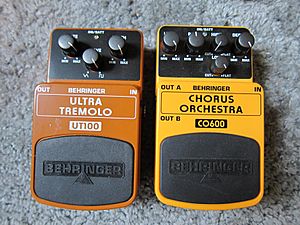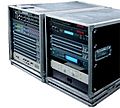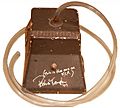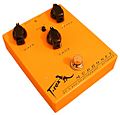Effect pedal facts for kids
An effect pedal is a small electronic device. It changes the sound of a musical instrument or a person's voice. Musicians use these pedals to make their sound more interesting or unique. Common effects include echo, chorus, distortion, tremolo, reverb and flanger. Most pedals for guitars connect using special phone connector cables.
Contents
What Are Effect Pedals?
Effect pedals are like special sound tools. They take the sound from an instrument, change it, and then send the new sound out. Imagine your guitar sound going into a pedal, getting changed, and then coming out sounding different. This lets musicians create many cool sounds.
How Do They Work?
Each effect pedal has electronic parts inside. These parts are designed to change the sound in a specific way. When you play your instrument, its sound signal travels through the pedal. The pedal then adds its special effect to the sound. After that, the changed sound goes to an amplifier or speaker.
Most pedals are small boxes you put on the floor. You press a switch with your foot to turn the effect on or off. This is why they are often called "stompboxes."
Different Kinds of Effects
There are many types of effect pedals. Each one creates a unique sound. Here are some popular ones:
Echo and Delay
An echo effect makes your sound repeat. It's like shouting in a big cave and hearing your voice bounce back. A delay pedal lets you control how many times the sound repeats. It also lets you control how long it takes for the repeats to happen. This can make a single note sound like many notes.
Chorus
A chorus effect makes one instrument sound like many. It does this by making several slightly detuned copies of the original sound. These copies are played at slightly different times. It can make a guitar sound like a whole group of guitars playing together.
Distortion and Overdrive
Distortion and overdrive pedals make the sound rough and gritty. They are very popular with rock and metal guitarists. Overdrive gives a warm, slightly fuzzy sound. Distortion makes the sound much more aggressive and powerful. A fuzz pedal is a type of distortion that creates a very thick, buzzy sound.
Tremolo
Tremolo makes the volume of your sound go up and down quickly. It creates a pulsing effect. Think of it like someone quickly turning your volume knob up and down. This can add a wavy, shimmering feel to the music.
Reverb
Reverb makes your sound seem like it's in a big space. It adds echoes that quickly fade away. It's like playing in a large hall or a church. Reverb can make a sound feel bigger and more open.
Wah-wah
A wah-wah pedal changes the tone of your sound. It makes a "wah-wah" sound, like a human voice. You control it by rocking your foot on the pedal. This effect is often used in funk and rock music.
Phaser and Flanger
Phaser and flanger pedals create a swirling, sweeping sound. They do this by splitting the sound signal. One part is delayed slightly, and then the two parts are mixed back together. This creates a cool, whooshing effect.
Multi-Effects Pedals
Some pedals are called multi-effects pedals. These pedals have many different effects built into one unit. They are great for musicians who want a lot of sounds without buying many separate pedals. They can also save space.
Using Pedals Together
Musicians often use several pedals at once. They connect them in a line, one after another. This is called a signal chain. The order of the pedals can change the final sound a lot. For example, a distortion pedal before a delay pedal will sound different than a delay pedal before a distortion pedal.
Many musicians put their pedals on a special board called a pedalboard. This keeps the pedals organized and makes them easy to carry.
Images for kids
-
A pedalboard allows a performer to create a ready-to-use chain of multiple pedals to achieve certain types of sounds. Signal chain order: tuner, compressor, octave generator, wah-wah pedal, overdrive, distortion, fuzz, EQ and tremolo.
-
An example of an effects chain. From the input [right] to the output [left]:
- Tuner [upper right] (tc electronic Polytune) ⇒
- Wah pedal [lower right] (Morley Bad Horsie Wah) ⇒
- Overdrives/distortion [lower row] (Rocktron Short Timer Delay → Danelectro CTO-1 Transparent Overdrive → Boss HM-2 → Boss MT-2) ⇒
- Modulations/delay [upper row] (Digitech Hyper Phase → Danelectro CV-1 Vibe → Danelectro CT Tremolo → Digitech Hyper Delay)
-
A Fender Vibrolux Reverb amp and a ROSS amp
-
Peter Frampton's Talk box.
See also
 In Spanish: Unidad de efectos para niños
In Spanish: Unidad de efectos para niños


























